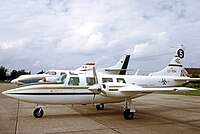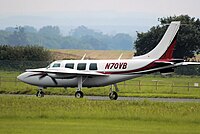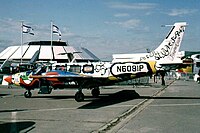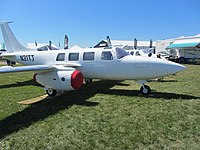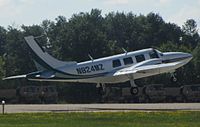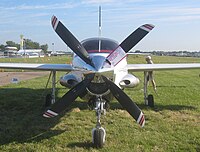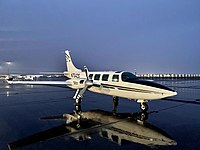Piper Aerostar
| Aerostar / Superstar / Sequoya | |
|---|---|
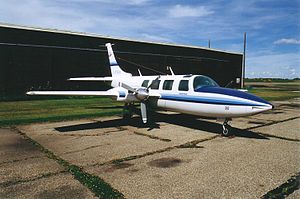
| |
| An Aerostar 600 in Red Deer, Alberta in 2000 | |
| Role | Light transport aircraft |
| National origin | United States |
| Manufacturer | Ted Smith Aircraft Company Piper Aircraft Corporation |
| Designer | Ted R. Smith |
| First flight | 1967 |
| Status | Active service |
| Produced | 1967–1984 |
| Number built | 1,010 |
The Piper Aerostar (formerly the Ted Smith Aerostar) is an American twin-engined propeller-driven executive or light transport aircraft, designed by Ted R. Smith. It was originally built by Ted Smith Aircraft Company, but the design was acquired in 1978 by the Piper Aircraft Corporation, which continued production of the aircraft as the PA-60.
Design and development[edit]
The first Aerostar prototype, the Model 320, was built with two 160 hp (120 kW) Lycoming IO-320 engines and first flew in November 1966. The same aircraft was upgraded with a pair of 180 hp (130 kW) Lycoming IO-360 engines and a more streamlined vertical fin and renamed the Model 360; it was subsequently upgraded again with 200 hp (150 kW) IO-360s and renamed again as the Model 400. The aircraft finally entered production as the Aerostar 600 with two 290 hp (220 kW) Lycoming IO-540-K engines, first flown in December 1967.[1]
The Aerostar emerged as a mid-wing cantilever monoplane powered by two wing-mounted piston engines, with a tricycle landing gear. It was fitted with luxury accommodation for six. Also produced, and the base of most of the subsequent models, was a version with turbocharged engines, the Aerostar 601.[1]
During the time of production, the Aerostar held the speed record for fastest twin piston general aviation aircraft,[2] capable of cruise speeds from 220 kn (408 km/h) for the earliest 600 models to 261 kn (483 km/h) for the later 700 models. Light construction, low drag and high powered engines also contribute to fast climb rates.
Aerostar model numbers nominally refer to the total installed engine horsepower, but some model numbers vary from the precise total, particularly the later models.[3]
Operational history[edit]
The aircraft were originally built at Van Nuys, California, but in 1968 the company was bought by the American Cement Company. The acquisition was not a success, and in 1969 the company was sold again to Butler Aviation, owners of Mooney Airplane Company. The new company was renamed Aerostar Aircraft Corporation, and plans were made to move production to the Mooney plant at Kerrville, Texas, but this did not occur.[3] In 1971, Smith attempted to purchase the rights and announced he would be building an all-new design that was better than the Aerostar, but negotiations broke down.[4] In 1972, Ted Smith successfully bought back all the rights to the aircraft and began manufacturing Aerostars under the Ted R. Smith and Associates banner in Santa Maria, California, introducing the pressurized Aerostar 601P along with the Aerostar 700 Superstar. In 1976, the company name was changed to the Ted Smith Aerostar Corporation.[3] Ted Smith died in 1976.[citation needed]
In 1978, the Aerostar line was acquired by the Piper Aircraft Corporation, which continued to build two variants, the 600A and 601B, and then re-introduced the 601P.[3] Piper continued using the Ted Smith model designation system but prefixed each model as the PA-60.[1][5] Piper introduced the enhanced 602P, which was initially marketed as the Sequoya.[3][a] After discontinuing production of the non-pressurized models, Piper moved production to Vero Beach, Florida, building the last Aerostar there in 1984.[3]
The Aerostar type certificate and manufacturing documentation were sold in 1991 to Jim Christy and Steve Speer, who had been part of the Ted Smith Aerostar operation, and now operate Aerostar Aircraft Corporation in Hayden Idaho, providing maintenance and support of the aircraft and new R&D of its family of aircraft. Conceived with a jet-powered design structure by Ted Smith from the very beginning, the Aerostar Aircraft Corporation continued its R&D and finally completed Ted Smith's dream to convert the design into a twin fan-jet aircraft, with 6 seats (including one pilot) and its version of the 8-seat stretched variant.[6]
Variants[edit]
- Model 320
- First prototype, powered by two 160 hp (120 kW) Lycoming IO-320 engines[7]
- Model 360
- Modification of first prototype with two 180 hp (130 kW) Lycoming IO-360 engines and a redesigned empennage[1][8]
- Model 400
- Modification of first prototype with two 200 hp (150 kW) IO-360 engines; type certified, but did not enter production[7][8]
- Model 500/500P
- Projected versions with 250 hp (190 kW) fuel injected engines, to be non-pressurized and pressurized respectively; none built[7]
- 600 (later PA-60-600)
- Initial production model with two 290 hp (220 kW) Lycoming IO-540-K engines,[5] 282 produced under four different company names[7]
- 600A
- Model 600 with some minor detail changes[7]
- 600E
- Designation used for aircraft sold in Europe[7]
- 601 (later PA-60-601)
- This aircraft still holds the land closed speed record for a production piston twin[citation needed]
- Model 600 with 290 hp turbocharged Lycoming TIO-540 engines,[5] 117 built[7]
- 601B
- Model 601 with increased wingspan, 44 built[7]
- 601P (later PA-60-601P)
- Pressurized version of 601 with increased gross weight,[5] 492 built[7]
- 602P Sequoya (later PA-60-602P)
- Piper-developed version of 601P with 290 hp Lycoming TIO-540-AA1A5 engines, 124 built[5][7]
- 620
- The prototype pressurized Aerostar with 310 hp (230 kW) TIO-540 engines, one built[7] (at Van Nuys in mid-1969)[citation needed]
- 700 Superstar
- Prototype of stretched fuselage variant with two IO-540M engines, one built[7]
- 700P (later PA-60-700P)
- 602P with counter-rotating 350 hp (260 kW) Lycoming TIO-540-U2A engines,[5] 26 built[7]
- 702P
- New modification of 700P with a reinforced nose gear allowing for higher takeoff weight[citation needed]
- 800
- 601P with stretched fuselage, enlarged tail and two 400 hp (300 kW) Lycoming engines, one built[7]
- Speedstar 850
- A modification to replace the twin piston engines with a single nose mounted turboprop[9]
-
Ted Smith-built Aerostar 601 in 1971
-
Piper PA-60-600 Aerostar, built in 1977
-
A Piper Sequoia 602P at Paris Air Show Le Bourget in 1981
-
An experimental turbine powered Aerostar FJ-80 in 2011
-
1980 Aerostar 601P
-
Speedstar 850
-
Aerostar 600
Specifications (700P)[edit]
Data from Jane's Civil and Military Aircraft Upgrades 1994–95[10]
General characteristics
- Crew: 1
- Capacity: 5 passengers
- Length: 34 ft 9.75 in (10.61 m)
- Wingspan: 36 ft 8 in (11.18 m)
- Height: 12 ft 1 in (3.68 m)
- Wing area: 178.2 sq ft (16.56 m2)
- Empty weight: 4,275 lb (1,939 kg)
- Gross weight: 6,315 lb (2,864 kg)
- Powerplant: 2 × Avco Lycoming TIO-540-U2A flat six counter-rotating piston , 350 hp (261 kW) each
Performance
- Maximum speed: 306 mph (492 km/h, 266 kn)
- Cruise speed: 242 mph (390 km/h, 210 kn) [11]
- Range: 1,024 mi (1,648 km, 890 nmi)
- Service ceiling: 25,000 ft (7,620 m)
- Rate of climb: 1,840 ft/min (9.4 m/s)
References[edit]
Notes[edit]
Citations[edit]
- ^ a b c d e Simpson 1991, pp. 326–327.
- ^ "Certified Aircraft Database: Aerostar". Pilotfriend.com. Retrieved 24 February 2019.
- ^ a b c d e f Simpson 1991, p. 326.
- ^ Air Progress: 16. December 1971.
{{cite journal}}: Missing or empty|title=(help) - ^ a b c d e f "Type Certificate Data Sheet No. A17WE". Federal Aviation Administration. Retrieved June 12, 2024.
- ^ Hirschman, Dave. "Ted Smith's Dream: Record-setting piston twin sprouts jet engines". AOPA, February 5, 2014. Retrieved 24 February 2019.
- ^ a b c d e f g h i j k l m n Simpson 1991, p. 327.
- ^ a b Taylor 1967, p. 360.
- ^ Twin and Turbine Magazine. September 2010.
{{cite journal}}: Missing or empty|title=(help) - ^ Michell 1994, pp. 385–386.
- ^ 55% power
Bibliography[edit]
- The Illustrated Encyclopedia of Aircraft (Part Work 1982–1985), 1985, Orbis Publishing
- Michell, Simon. Jane's Civil and Military Aircraft Upgrades 1994–95. Coulsdon, UK: Jane's Information Group, 1994. ISBN 0-7106-1208-7.
- Simpson, R.W. Airlife's General Aviation, 1991, Airlife Publishing, ISBN 1-85310-194-X
- Taylor, John W. R. Jane's All The World's Aircraft 1967–68. London: Sampson Low, Marston & Company, 1967.
External links[edit]
 Media related to Piper Aerostar at Wikimedia Commons
Media related to Piper Aerostar at Wikimedia Commons

